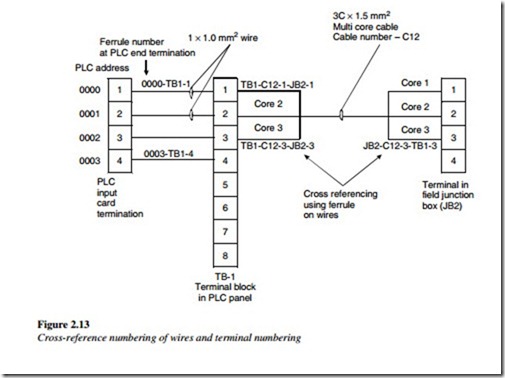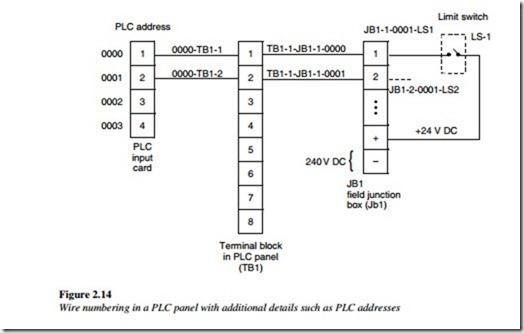Wires and terminal numbering
In any electrical control panel, there are wires to which various electrical devices are connected.
It is important that electrical devices in a circuit are connected accurately through wires with proper voltages and polarity.
To ensure proper connections of wires, devices as well as terminals (through which they are routed) are given unique numbers.
This practice is followed for designing, assembling, and maintenance. This helps in identifying the devices, wires, and terminals during troubleshooting.
In an electrical panel, terminals are used to connect the wires. Generally, they are grouped together and called ‘Terminal Block’. They are grouped either as per their functional use or as per the device connected.
Each terminal block consists of a group of terminals with an assigned ‘Terminal Block Number’. Each terminal on the block is assigned a unique ‘Terminal Number’.
In a panel, usually one side of the terminal is used for connecting internal wires from the devices inside the panel, and the other side is used for field or external connections.
In electrical panels, wires and cores of multi-core cables are used for interconnections. Wires and cable cores are terminated on device terminals and terminal blocks. Wires and cable cores used for interconnection are numbered. Alphabetical symbols and numberedferrules are used on each wire or core of the cables.
The numbering of wires should consist of the following details:
• Cable number
• Wire or core number of the multi-core cable
• Terminal block number
• Terminal number on which the wire is to be terminated.
As a wire is connected at two ends, it is quite useful to use a cross-referencing method for numbering the wires. Cross-referencing of wires or cable cores include the details of the other end of the wire where it is terminated. Details such as ‘Panel Number’, ‘Terminal Block Number’, and ‘Terminal Number’ of the other end of the wire are also included apart from the above-mentioned details of the termination end.
Cross-reference wire numbering and terminal numbering is shown in Figure 2.13.
Though the wire numbering and terminal numbering shown in the figure is typical, in practice, there are many ways and methods of numbering wires and terminals that may be adopted. A cross-referencing number is one of the methods found useful during cable laying and termination, continuity testing, and troubleshooting.
As shown in Figure 2.13, cross ferruling is used between TB1 and JB2 terminal blocks for cable C12 cores. The ferrule at TB2 terminal block gives an idea of where the other end of the core is connected.
For example, as shown in the Figure 2.14, a PLC panel wiring along with cross- reference ferruling, PLC address information is also included. It is quite useful to include the PLC address in the wire ferrule number apart from the cable number, core number, terminal number, and cross-reference detail for troubleshooting.
In Figure 2.14, cross-referencing ferruling is used for field devices and terminal block wiring, as well as inter-terminal block wiring. Although this kind of ferruling involves lengthy ferrule numbers, the practice is certainly worth the effort while troubleshooting.
Related posts:
Incoming search terms:
- cross ferruling
- ferrule numbering standards
- Electrical Wires mail
- eletrical panal cabal trmination
- electrical letters to numbers conections
- j ferul use in dc and k ferul use in ac why
- federal reference number for the wire uk
- wire numbering schematic
- how to assign wire numbers in electrical schematics
- what is ferruling of cable
- ___ the wire reference numbers is a common method to help differentiate wire reference numbers from other numbering systems
- wire numbering methods
- control panel terminal block wiring
- number ferrules
- wires and cables mail
- what is invovled in a terminal numbering system
- ferruling in electrical system
- ferruling of cable
- PLC FROR WILDECK PANEL NUMBER 3534CE
- terminal block numbering standard
- why are the ferrules are usedin contro cable
- Wire -Feeding Equipment mail
- wire numbering nomenclature
- wire terminal numbers
- ferrule number
- cable numbering and termination drawing ?
- how house wiring diagram add ferrule Numbering
- electrical control panel symbol
- ferrules of electrical equipment
- Panel wiring sym
- what is the use of ferrules in controlpanel
- control panel wire numbering standard
- electrical panel numbering
- electrical panel diagram numbering system
- cabel wires mail
- alphabetic ferrule used in control panel wiring
- ELECTRICAL FERRULE NUMBERING
- bus cable nomenclature numbering
- electrical ferul diteles
- control wiring ferrul
- cables ferruling
- control wiring ferruling
- cross ferrule plc
- control pannale wiring ferul numbring
- Cross ferruling cable
- cross ferruling in eplan
- control wiring ferrule numbers
- circuit numbering and wire identification
- circuit id cable numbers
- Cables Wires and Electrical cords mail

